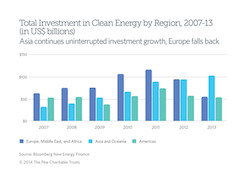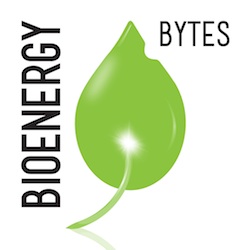According to research from The Pew Charitable Trusts, the U.S. clean energy sector continues to be buffeted by policy uncertainty with 2013 investment down 9 percent from 2012 to $36.7 billion. The annual report, “Who’s Winning the Clean Energy Race? 2013,” found that steep declines in the installation of wind overshadowed a record annual deployment of 4.4 gigawatts of solar.
 “Lower technology prices have made the small-distributed solar market very competitive, and the United States has been a leader in developing innovative financing models that are spurring steadily increasing deployment,” said Phyllis Cuttino, director of Pew’s clean energy program. “We also remain a world leader in venture capital, biofuels, and energy-smart technologies, like smart meters and LED lighting. Wind, however, has been subject to the vagaries of U.S. energy policy. As Congress debates tax extenders, it should aim to level the playing field, accelerate clean energy deployment, and provide long-term certainty to investors.”
“Lower technology prices have made the small-distributed solar market very competitive, and the United States has been a leader in developing innovative financing models that are spurring steadily increasing deployment,” said Phyllis Cuttino, director of Pew’s clean energy program. “We also remain a world leader in venture capital, biofuels, and energy-smart technologies, like smart meters and LED lighting. Wind, however, has been subject to the vagaries of U.S. energy policy. As Congress debates tax extenders, it should aim to level the playing field, accelerate clean energy deployment, and provide long-term certainty to investors.”
The report found in the U.S. marketplace, solar technology prices have declined 60 percent since 2011, and new financing models have spurred more than $17 billion in investment, a 7 percent increase from 2012. The U.S. continued to garner world-leading financing in the biofuels and energy efficient/low-carbon technology subsectors. It also remained the dominant recipient of public market and venture capital/private equity investment, attracting $6.8 billion and $2.2 billion, respectively.
Although wind investment was relatively stable at $14 billion, U.S. wind installations in 2013 were down more than 90 percent—from more than 13 GW in 2012 to less than 1 GW last year found the report. When the production tax credit was renewed in early 2013, slight changes in the law precipitated deferrals in deployment of new wind capacity into 2014, when a strong rebound in capacity additions was forecast. By comparison, China deployed 12.1 GW of solar and 14.1 GW of wind capacity.
The regional and global market remains dominated by China, attracting $54.2 billion, with the U.S. in second place. Japan was third with $28.6 billion. Globally, clean energy investment fell 11 percent, to $254 billion, and renewable power generating capacity additions declined by 1 percent in 2013. Overall, installed clean energy capacity reached 735 GW.
 Twelve states produced 80% of the total wind energy generated last year, according to preliminary data released from the Energy Information Administration (EIA) in the March Electric Power Monthly report.
Twelve states produced 80% of the total wind energy generated last year, according to preliminary data released from the Energy Information Administration (EIA) in the March Electric Power Monthly report. 










